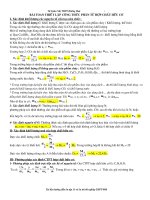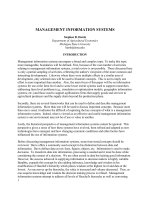- Trang chủ >>
- THPT Quốc Gia >>
- Ngữ Văn
solution to stack data management on systems with scratch pad memory
Bạn đang xem bản rút gọn của tài liệu. Xem và tải ngay bản đầy đủ của tài liệu tại đây (543.64 KB, 46 trang )
<span class='text_page_counter'>(1)</span>A SOFTWARE-ONLY SOLUTION TO STACK DATA MANAGEMENT ON SYSTEMS WITH SCRATCH PAD MEMORY Arun Kannan 14th October 2008 Compiler and Micro-architecture Lab Computer Science and Engineering. Arizona State University.
<span class='text_page_counter'>(2)</span> Multi-core Architecture Trends . . . . Multi-core Advantage . Lower operating frequency. . Simpler in design. . Scales well in power consumption. New Architectures are ‘Many-core’ . IBM Cell (10-core). . Intel Tera-Scale (80-core) prototype. Challenges . Scalable memory hierarchy. . Cache coherency problems magnify. . Need power-efficient memory (Caches consume 44% in core). Distributed Memory architectures are getting popular . Uses alternative low latency, on-chip memories, called Scratch Pads.
<span class='text_page_counter'>(3)</span> Scratch Pad Memory (SPM) . . . High speed SRAM internal memory for CPU Directly mapped to processor’s address space SPM is at the same level as L1-Caches in memory hierarchy SPM. CP U. CPU Regist ers. L1 Cach e. L2 Cach e. SPM. RA M. IBM Cell Architecture.
<span class='text_page_counter'>(4)</span> SPM more power efficient than Cache .. 9 8. Tag Array. Data Array. Tag Comparators, Muxes. Address Decoder. Energy per access [nJ]. 7 6 Scratch pad 5. Cache, 2way, 4GB space. 4. Cache, 2way, 16 MB space Cache, 2way, 1 MB space. 3 2 1 0 256. 512. 1024. 2048. 4096. 8192. 16384. memory size. Cache SPM . 40% less energy as compared to cache . . 34 % less area as compared to cache of same size . . Absence of tag arrays, comparators and muxes Simple hardware design (only a memory array & address decoding circuitry). Faster access to SPM than cache.
<span class='text_page_counter'>(5)</span> Agenda . . Trend towards distributed-memory multi-core architectures Scratch Pad Memory is scalable and power-efficient Problems and Objectives Related work Proposed Technique An Optimization An Extension Experimental Results Conclusions.
<span class='text_page_counter'>(6)</span> Using SPM What if the SPM cannot fit all the data? int global;. int global;. f1(){ int a,b; global = a + b; f2(); }. f1(){ int a,b; DSPM.fetch(global) global = a + b; DSPM.writeback(global) ISPM.fetch(f2) f2(); }. . Original Code. . SPM Aware Code.
<span class='text_page_counter'>(7)</span> What do we need to use SPM? . Partition available SPM resource among different data . . Identifying data which will benefit from placement in SPM . . Global, code, stack, heap Frequently accessed data. Minimize data movement to/from SPM . Coarse granularity of data transfer. . Optimal data allocation is an NP-complete problem. . Binary Compatibility . . Application compiled for specific SPM size. Need completely automated solutions.
<span class='text_page_counter'>(8)</span> Application Data Mapping . Objective . . Reduce Energy consumption Minimal performance overhead. Each type of data has different characteristics . Global Data . . Stack Data . . ‘live’ throughout execution Size known at compile-time ‘liveness’ depends on call path Size known at compile-time Stack depth unknown. Heap Data . Extremely dynamic Size unknown at compiletime. MiBench Suite. Stack data enjoys 64.29% of total data accesses.
<span class='text_page_counter'>(9)</span> Challenges in Stack Management . Stack data challenge . . ‘live’ only in active call path Multiple objects of same name exist at different addresses (recursion) Address of data depends on call path traversed Estimation of stack depth may not be possible at compile-time Level of granularity (variables, frames). Goals . Provide a pure-software solution to stack management Achieve energy savings with minimal performance overhead Solution should be scalable and binary compatible.
<span class='text_page_counter'>(10)</span> Agenda . Trend towards distributed-memory multicore architectures Scratch Pad Memory is scalable and powerefficient Problems and Objectives Related work Proposed Technique An Optimization An Extension Experimental Results Conclusions.
<span class='text_page_counter'>(11)</span> Need Dynamic Mapping Techniques SPM Stati c. . Static Techniques . . Dynam ic. The contents of the SPM remain constant throughout the execution of the program. Dynamic Techniques . Contents of SPM adapt to the access pattern in different regions of a program. . Dynamic techniques have proven superior.
<span class='text_page_counter'>(12)</span> Cannot use Profile-based Methods SPM Stati c. Dynam ic Profilebased. . . Non-Profile. Profiling . Get the data access pattern. . Use an ILP to get the optimal placement or a heuristic. Drawbacks . Profile may depend heavily depend on input data set. . Infeasible for larger applications. . ILP solutions do not scale well with problem size.
<span class='text_page_counter'>(13)</span> Need Software Solutions SPM Stati c. Dyna mic Profilebased. . Use additional/modified hardware to perform SPM management . . NonProfile Hardwa Softwar re e. SPM managed as pages, requires an SPM aware MMU hardware. Drawbacks . Require architectural change. . Binary compatibility. . Loss of portability. . Increases cost, complexity.
<span class='text_page_counter'>(14)</span> Agenda . . Trend towards distributed-memory multi-core architectures Scratch Pad Memory is scalable and power-efficient Problems and Objectives Limitations of previous efforts Our Approach: Circular Stack Management An Optimization An Extension Experimental Results Conclusions.
<span class='text_page_counter'>(15)</span> Circular Stack Management F 1. SPM Size = 128 bytes. F4 F 2 F 3. Old F 4. Functio n. Frame Size (bytes). F1. 28. F2. 40. F3. 60. F4. 54. SP F1 F2. dramSP 28 54 68. F3 128. SPM. DRAM.
<span class='text_page_counter'>(16)</span> Circular Stack Management . . Manage the active portion of application stack data on SPM Granularity of stack frames chosen to minimize management overhead . . Who does this management? . . Eviction also performed in units of stack frames Software SPM Manager Compiler framework to instrument the application. It is a dynamic, profile-independent, software technique.
<span class='text_page_counter'>(17)</span> Software SPM Manager (SPMM) Operation . Function Table . . . The system SPM size is determined at run-time during initialization Before each user function call, SPMM checks . . Compile-time generated structure Stores function id and its stack frame size. Required function frame size from Function Table Check for available space in SPM Move old frame(s) to DRAM if needed. On return from each user function call, SPMM checks . Check if the parent frame exists in SPM! Fetch from DRAM, if it is absent.
<span class='text_page_counter'>(18)</span> Software SPM Manager Library . . . Software Memory Manager used to maintain active stack on SPM SPMM is a library linked with the application . spmm_check_in(int);. . spmm_check_out(int);. . spmm_init();. Compiler instruments the application to insert required calls to SPMM spmm_check_in(Foo); Foo(); spmm_check_out(Foo);.
<span class='text_page_counter'>(19)</span> SPMM Challenges . SPMM needs some stack space itself . . . Managed on a reserved stack area. SPMM does not use standard library functions to minimize overhead Concerns . . Performance degradation due to excessive calls to SPMM Operation of SPMM for applications with pointers.
<span class='text_page_counter'>(20)</span> Agenda . . Trend towards distributed-memory multi-core architectures Scratch Pad Memory is scalable and power-efficient Problems and Objectives Limitations of previous efforts Circular Stack Management Challenges . Extension for Pointers Experimental Results Conclusions . . Call Overhead Reduction.
<span class='text_page_counter'>(21)</span> Call Overhead Reduction . . SPMM calls overhead can be high Three common cases Opportunities to reduce repeated SPMM calls by consolidation Need both, the call flow and control flow graph. spmm_check_in(F1,F2); spmm_check_in(F1); F1(); spmm_check_out(F1); F2(); spmm_check_in(F2); spmm_check_out(F1,F2) F2(); spmm_check_out(F2);. spmm_check_in(F1,F2); spmm_check_in(F1) F1(){ spmm_check_in(F2); F2(); F2(); } spmm_check_out(F2); spmm_check_out(F1,F2); } spmm_check_out(F1). Sequential Calls. Nested Call. spmm_check_in(F1); while(<condition>){ while(<condition>){ spmm_check_in(F1); F1(); } spmm_check_out(F1); } spmm_check_out(F1);. Call in loop.
<span class='text_page_counter'>(22)</span> Global Call Control Flow Graph (GCCFG) MAIN ( ) F1( ) for F2 ( ) end for END MAIN F5 (condition) if (condition) condition = … F5() end if END F5. . F2 ( ) for F6 ( ) F3 ( ) while F4 ( ) end while end for F5() END F2. mai n. F1. L1. F2. F5. L2 L3 F6. F3. Advantages . . Strict ordering among the nodes. Left child is called before the right child Control information included (Loop nodes ) Recursive functions identified. F4.
<span class='text_page_counter'>(23)</span> Optimization using GCCFG Mai n. Mai n. F1. SPMM in SPMM F1+ in F1 max(F2,F3). L1 F2. F1. SPMM out SPMM F1+ out F1 max(F2,F3). F3. GCCFG SPMM out. SPMM in max(F2,F 3) SPMM in max(F2,F 3). L1. max(F2,F 3) SPMM out. SPMM in F2. F2. SPMM out F2. SPMM in F3. F3. GCCFG GCCFG GCCFG GCCFGun-optimized ---Sequence Nested Loop. SPMM out F3. max(F2,F 3).
<span class='text_page_counter'>(24)</span> Agenda . . Trend towards distributed-memory multi-core architectures Scratch Pad Memory is scalable and power-efficient Problems and Objectives Limitations of previous efforts Circular Stack Management Challenges . . Call Overhead Reduction Extension for Pointers. Experimental Results Conclusions.
<span class='text_page_counter'>(25)</span> Run-time Pointer-to-Stack The Pointer threat Resolution void foo(void){ int local = -1; int k = 8; bar(k,&local) print(“%d”,local); }. bark=1 Old. void bar(int k, int *ptr){ if (k == 1){ *ptr = 1000; return; } bar(--k,ptr); }. local. SP foo bark=5 bark=4 bark=3 bark=2. foo bark=3. bark=5 bark=2. bark=4 bark=1. SPM State List. SPM. dramSP. 400. 24. 424. 32 56 80 104 128. DRAM. SPMM call before bark=1 inspects the pointer argume i.e. address of variable ‘local’ = 24 Uses SPM State List to get new address 424.
<span class='text_page_counter'>(26)</span> The Pointer Threat . . . Circular stack management can corrupt some pointer-to-stack references Need to ensure correctness of program execution Pointers to global/heap data are unaffected Detection and analyzing all pointers-to-stack is a non-trivial problem Assumptions . Data from other stack frames accessed only through pointers arguments There is no type-casting in the program Pointers-to-stack are not passed within structure arguments.
<span class='text_page_counter'>(27)</span> Run-time Pointer-to-Stack Resolution . . Additional software overhead to ensure correctness For the given assumptions . . Applications with pointers can still run correctly. Stronger static analysis can allow support for more benchmarks.
<span class='text_page_counter'>(28)</span> Agenda . . Trend towards distributed-memory multi-core architectures Scratch Pad Memory is scalable and power-efficient Problems and Objectives Limitations of previous efforts Circular Stack Management Challenges Call Reduction Optimization Extension for Pointers . . Experimental Results Conclusions.
<span class='text_page_counter'>(29)</span> Experimental Setup . Cycle accurate SimpleScalar simulator for ARM MiBench suite of embedded applications Energy models . . . Obtained from CACTI 5.2 for SPM Obtained from datasheet for Samsung Mobile SDRAM. SPM size is chosen based on maximum function stack frame in application Compare Energy and Performance for . System without SPM, 1k cache (Baseline) System with SPM . Circular stack management (SPMM) SPMM optimized using GCCFG (GCCFG) SPMM with pointer resolution (SPMM-Pointer).
<span class='text_page_counter'>(30)</span> Energy Reduction Baseline. Average 37% reduction with SPMM combined with GCCFG optimization.
<span class='text_page_counter'>(31)</span> Performance Improvement Baseline. Average 18% performance improvement with SPMM combined with GCCFG.
<span class='text_page_counter'>(32)</span> Agenda . . Trend towards distributed-memory multi-core architectures Scratch Pad Memory is scalable and power-efficient Problems and Objectives Limitations of previous efforts Circular Stack Management Challenges Call Reduction Optimization Extension for Pointers . . Experimental Results Conclusions.
<span class='text_page_counter'>(33)</span> Conclusions . . . . Proposed a dynamic, pure-software stack management technique on SPM Achieved average energy reduction of 32% with performance improvement of 13% The GCCFG-based static analysis method reduces overhead of SPMM calls Proposed an extension to use SPMM for applications with pointers.
<span class='text_page_counter'>(34)</span> Future Directions . A static tool to check for assumptions of run-time pointer resolution . Is it possible to statically analyze? . . . If yes, Pointer-safe SPM size. What if the max. function stack > SPM stack partition? How to decide the size of stack partition? How to dynamically change the stack partition on SPM . Based on run-time information.
<span class='text_page_counter'>(35)</span> Research Papers . “A Software Solution for Dynamic Stack Management on Scratch Pad Memory” . . “SDRM: Simultaneous Determination of Regions and Function-to-Region Mapping for Scratchpad Memories” . . Accepted in the 15th IEEE International Conference on High Performance Computing, HiPC 2008. “A Software-only solution to stack data management on systems with scratch pad memory” . . Accepted in the 14th Asia and South Pacific Design Automation Conference, ASPDAC 2009. To be submitted in IEEE Transactions on Computer-aided Design. “SPMs: Life Beyond Embedded Systems” . To be submitted in IEEE Transactions on Computer-aided Design.
<span class='text_page_counter'>(36)</span> Thank you!.
<span class='text_page_counter'>(37)</span> Additional Slides.
<span class='text_page_counter'>(38)</span> Application Data Mapping . Objective . . Reduce Energy consumption Minimal performance overhead. Each type of data has different characteristics . Global Data . . Stack Data . . ‘live’ throughout the execution Constant address Size known at compile-time ‘live’ in active call path Multiple objects of same name exist at different addresses (recursion) Address of data depends on call path traversed Size known at compile-time Stack depth cannot be estimated at compile-time. Heap Data . ‘liveness’ may vary dependent on program Address constant, known only at run-time Size dependent on input-data.
<span class='text_page_counter'>(39)</span> Stack Data Management on SPM . MiBench Benchmark of Embedded Applications. . Stack data enjoy 64.29% of total data accesses. . The Objective . Provide a pure-software solution to stack management. . Achieve energy savings with minimal performance overhead. . Solution should be scalable and binary compatible.
<span class='text_page_counter'>(40)</span> Taxonomy. SP M Static Profilebased. Dynami c Non-Profile Hardwa re. Softwar e.
<span class='text_page_counter'>(41)</span> Need for methods which are … . . . Pure software Dynamic – SPM contents can change during execution Works on static analysis Does not require profiling the application Scales for any size/type of application (embedded, general purpose) Does not impose architectural changes Maintains binary compatibility.
<span class='text_page_counter'>(42)</span> SPMM Data Structures . Function Table . . Compile-time generated structure Stores function Id and its stack frame size. SPM State List . Run-time generated structure Holds the list of current active stack frames in call order Each node of the list contains . . Start address of the frame in SPM Number of evicted bytes of parent frame(s). Global pointers to stack areas . SP for SPM area (program stack) SP for SPMM (manager stack) Pointer to top of evicted frames in DRAM Pointer to oldest frame in SPM.
<span class='text_page_counter'>(43)</span> Call Consolidation Algorithm.
<span class='text_page_counter'>(44)</span> Energy Reduction with Pointer resolution Baseline. verage 29% reduction with SPMM-Pointer Benchmarks running with smaller SPM siz mpared to 32% with SPMM only in SPMM-Pointer.
<span class='text_page_counter'>(45)</span> Performance with Pointer resolution Baseline. erage 10% performance improvementReduction of energy and performance th SPMM-Pointer improvement seen due to increased softw overhead.
<span class='text_page_counter'>(46)</span> Optimization using GCCFG F1. L1 F2. SPMM F1. SPMM F1. F1 L1 SPMM F2. F 2 SPMM F2. SPMM F3. F 3 SPM M F3. GCCFG with SPM Manager. F3. GCCFG. SPMM F1. SPMM F1 + max(F2,F3). F 1. F 1. F 1. L1. SPMM max(F2,F3 ). L1. SPMM max(F2,F3 ). F 2. F 3. GCCFG - Sequence. F 2. L1 F 2. F 3 GCCFG Loop. F 3. GCCFG Nested.
<span class='text_page_counter'>(47)</span>









